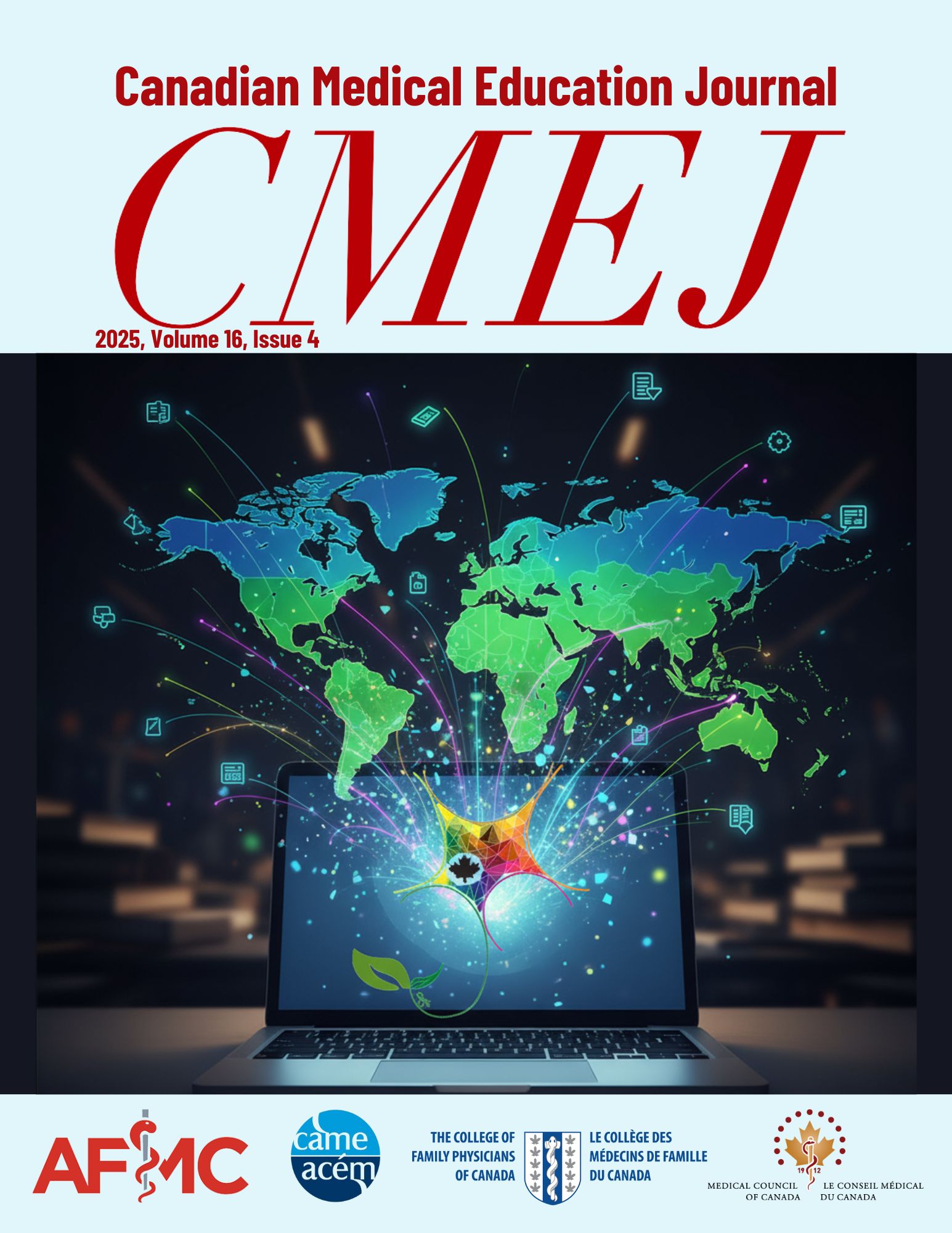Gender disparity in delayed childbearing among medical trainees in Ontario
DOI:
https://doi.org/10.36834/cmej.80415Abstract
Objective: Physicians report high rates of delayed childbearing and are at increased risk of infertility and pregnancy loss. There are limited studies on this topic in the Canadian context, particularly for trainees. Our objective was to explore Ontario medical trainees’ experiences with and knowledge of delayed childbearing, infertility, and fertility treatments.
Methods: We administered a cross-sectional survey to all residents and fellows in Ontario. Descriptive statistics, multiple regression, and thematic analysis of free text responses are used to present the findings.
Results: 460 trainees responded to the survey. Over half (57%) intentionally delayed childbearing due to medical training, with long working hours being the most cited reason (82%). Cis women were 85% more likely to delay family initiation than cis men. Rates of early pregnancy loss (17%) were similar to that of the Canadian average for this age group, while rates of infertility (14%) were slightly higher. Knowledge gaps were identified, with trainees scoring 62% on knowledge questions around age-related fertility decline and fertility treatment. The majority (73%) felt their programs were supportive of family initiation during training, with top areas for change identified as increased flexibility with working hours, and increased protected time for required extracurricular activities.
Conclusion: Trainee physicians in Ontario report high rates of delaying family initiation due to training, with greater impacts on cis women compared to cis men, and slightly higher rates of infertility. Addressing knowledge gaps is one way to empower trainees to make informed family planning decisions going forward.
Downloads
References
1. Rangel EL, Castillo-Angeles M, Easter SR, et al. Incidence of infertility and pregnancy complications in US female surgeons. JAMA Surg. 2021 Oct 1;156(10):905. https://doi.org/10.1001/jamasurg.2021.3301
2. Katz VL, Miller NH, Bowes WA. Pregnancy complications of physicians. West J Med. 1988 Dec 1;149(6):704–7. https://pmc.ncbi.nlm.nih.gov/articles/PMC1026619/ [Accessed on Oct 1, 2024].
3. Glauser W. Is the culture of medicine contributing to miscarriages among female physicians? CMAJ. 2019 Nov 3;191(44):E1229–30. https://doi.org/10.1503/cmaj.1095821
4. Wang A, Herndon CN, Mok-Lin E, Aghajanova L. Infertility, fertility preservation, and access to care during training: a nationwide multispecialty survey of United States residents and fellows. J Fertility Preserv. 2021;2:1–10. https://doi.org/10.32371/jfp/246110
5. Anderson M, Goldman RH. Occupational reproductive hazards for female surgeons in the operating room. JAMA Surg. 2020 Mar 1;155(3):243. https://doi.org/10.1001/jamasurg.2019.5420
6. Todd AR, Cawthorn TR, Temple-Oberle C. Pregnancy and parenthood remain challenging during surgical residency: a systematic review. Acad Med. 2020 Mar 31;95(10):1607–15. https://doi.org/10.1097/ACM.0000000000003351
7. Kudesia R, Chernyak E, McAvey B. Low fertility awareness in United States reproductive-aged women and medical trainees: creation and validation of the Fertility & Infertility Treatment Knowledge Score (FIT-KS). Fertility & Sterility. 2017 Oct; 108(4), 711–717. https://doi.org/10.1016/j.fertnstert.2017.07.1158
8. Cavanaugh J. and Neath A. The Akaike information criterion: background, derivation, properties, application, interpretation, and refinements. WIREs computational statistics 2019;11(3). https://doi.org/10.1002/wics.1460
9. Erlingsson C, Brysiewicz P. A hands-on guide to doing content analysis. Afr J Emerg Med. 2017;7(3):93–9. https://doi.org/10.1016/j.afjem.2017.08.001
10. Canadian Post-MD education registry. CAPER annual census of post-M.D. trainees. caper.ca. Available from: https://caper.ca/postgraduate-medical-education/annual-census. [Accessed on Mar 1, 2025].
11. Canadian Medical Association. CMA national physician health survey: a national snapshot. 2018 Oct. Available from: https://www.cma.ca/sites/default/files/2018-11/nph-survey-e.pdf. [Accessed on Mar 1, 2025].
12. Kneebone R, Wilkins M. Social policy trends: the average age of mothers at first birth. The school of public policy publications. 2024. Available from: https://journalhosting.ucalgary.ca/index.php/sppp/article/view/79060. [Accessed on Nov 22, 2024].
13. Bushnik T, Cook JL, Yuzpe AA, Tough S, Collins J. Estimating the prevalence of infertility in Canada. Human Reprod. 2012 Jan 17;27(3):738–46. https://doi.org/10.1093/humrep/der465
14. Van Tuyl, R. Improving access, understanding, and dignity during miscarriage recovery in British Columbia, Canada: A patient-oriented research study. Women’s Health. 2024 Jan 1;20. https://doi.org/10.1177/17455057231224180
15. Taylor HS, Fritz MA, Lubna Pal, Emre Seli. Speroff’s clinical gynecologic endocrinology and infertility. Philadelphia: Wolters Kluwer; 2020.
16. Shalaby R, Oluwasina F, Eboreime E, et al. Burnout among residents: prevalence and predictors of depersonalization, emotional exhaustion and professional unfulfillment among resident doctors in Canada. Intern J Environ Res Public Health. 2023 Jan 1;20(4):3677. https://doi.org/10.3390/ijerph20043677
17. Bakkensen JB, Smith KS, Cheung EO, et al. Childbearing, Infertility, and career trajectories among women in medicine. JAMA Network Open. 2023 Jul 27;6(7):e2326192. https://doi.org/10.1001/jamanetworkopen.2023.26192
18. Simpson AN, Cusimano MC, Baxter NN. The inconvenience of motherhood during a medical career. CMAJ. 2021 Sep 19;193(37):E1465–6. https://doi.org/10.1503/cmaj.211255
19. Family planning for medical trainees. Starting a family in training. 2024. Available from: https://www.familyplanningfordocs.com/starting-a-family-in-training. [Accessed on Nov 22, 2024].
Downloads
Published
How to Cite
Issue
Section
License
Copyright (c) 2025 Catherine L Friedman, Sarah Saliba, Azraa Janmohamed, Kestrel McNeill, Shirin Dason, Megan Karnis

This work is licensed under a Creative Commons Attribution-NonCommercial-NoDerivatives 4.0 International License.
Submission of an original manuscript to the Canadian Medical Education Journal will be taken to mean that it represents original work not previously published, that it is not being considered elsewhere for publication. If accepted for publication, it will be published online and it will not be published elsewhere in the same form, for commercial purposes, in any language, without the consent of the publisher.
Authors who publish in the Canadian Medical Education Journal agree to release their articles under the Creative Commons Attribution-Noncommercial-No Derivative Works 4.0 Canada Licence. This licence allows anyone to copy and distribute the article for non-commercial purposes provided that appropriate attribution is given. For details of the rights an author grants users of their work, please see the licence summary and the full licence.











